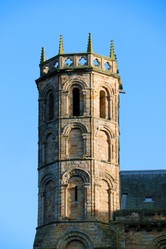The nation was saddened when the genial archaeologist and television personality Mick Aston died suddenly, but as a man who studied the traces of the past he left his own impact on archaeology, which included a generous legacy to fund research.The legacy funded a dig at Auckland Castle in County Durham, sometimes known as Auckland Palace, official residence of the Anglican bishops of Durham, the most senior clergy after the two archbishops, Canterbury and York.
So where is Durham? It is England's second most north-eastern county, just south of Northumberland. In the war-torn history of the county it has seen Viking raiders come and go and in the eleventh and twelfth centuries massive Scottish raids, during one of which in 1069 the population of the county town of Durham sheltered in the Cathedral while the Scottish horde approached until they were rescued by an advancing Norman army. This is an early instance of the Prince-bishops taking responsibility for security in the area.
From Norman times the bishops of Durham had special status, for the bishop was not merely a spiritual ruler, but a temporal one. He was earl palatine of Durham, a non-hereditary position responsible for civil government. The title palatine denotes responsibility for tax collection. The bishops dwelt at Durham Castle, a place of safety against Scottish [and English] raiders, but in the late thirteenth century they moved from the drafty castle to a newly-built Auckland [Northern English for Oakland] Palace. [The English raiders were the clans of the north Pennine hills and the Cheviots, who lived in a state of constant clan warfare, preying on both Scots and English.]
In 1283 Antony Bek became Bishop of Durham, and was the most famous of the Prince-bishops.He had been on crusade and represented the king in dealings with the Scots,including William Wallace, the renowned Braveheart. The new palace was near his deer park,whose meat was to provide food for his guests and extensive staff.It was said of Bishop Antony that there were two monarchs in England, King Edward the First and Bishop Antony. It was Antony who constructed Auckland Palace and the great chapel.It was just smaller than the chapel at the king's residence at Windsor Castle, a great national treasure.
The beautiful edifice survived the depredations of Henry the Eighth and the attentions of iconoclastic Protestants, possibly because its prince bishop was so powerful and maybe because the Durham area was very Catholic in sympathy, and the Stewart dynasty that succeeded the Tudors was uninterested in destroying anything, but its destruction was only delayed, for a second wave of fanaticism struck the country culminating in the mid seventeenth century.











 Pilgrimage. A review20 days ago
Pilgrimage. A review20 days ago
 Leo the Fourteenthon 05/09/2025
Leo the Fourteenthon 05/09/2025
 The Melsonby Hoardon 03/25/2025
The Melsonby Hoardon 03/25/2025




Comments
I think that our idiotic spell checker has been playing its silly games. I did not say Rochester, which is in Kent, but Ribchester, which is in Lancashire.
There were more instances of the recycling of stones in nearby buildings
Thank you for your comment below in answer to my previous observation and question.
Your answer references ruins nearby to a Lancashire inn at Rochester. Would there be any other recyclable stones or would they all have long been repurposed elsewhere?
Recyclingnof old stones was common. At Rochester in Lancashire there is an inn which has two pillars in its doorway salvaged from the Roman ruins nearby
Abandoned buildings intrigue me with their potential for anonymous or recognizable venues once their occupation is no more.
Might most looted stones from abandoned buildings in the British Isles recycle anonymously into other purposes in other places?
(That perhaps likeliest would be their Unitedstatesian fate ;-{.)
Like many buildings decayed slowly from neglect and quickly when its stones were looted for building stone.
The third paragraph to the first subheading, The prince-bishops, advises us of its predecessor abandoned for the thirteenth-century Auckland Palace.
Did the "drafty castle" decline quickly or slowly or did it do some duty as something else?
Speaking of Hesilrige, I think it worth saying that Calvinists were nearly as keen to persecute Anglicans [Episcopalians] as they were to persecute Catholics. For example, the Scottish Covenanters [Calvinists] violently displaced Episcopalian ministers in Scotland during the seventeenth century.
Thanks.
Wow Frank. I knew nothing of this.
Your religious and historical backgrounds and interpretations are superb. So much in fact I could just get on a train up to the very far North of England and visit Durham . Ty
I meant below the ground, a slip of words, but I believe it also does work below the seafloor.